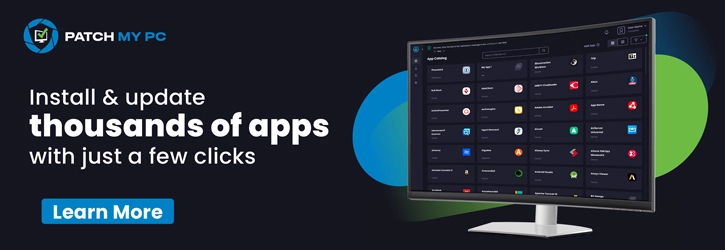Today we are on topic that How to Allow or Block Graphing Calculator using Intune Policy As you all know about Intune and its feature called Settings Catalog. This is one of the crucial steps for users to deploy a policy through organizations.
Microsoft Intune is a cloud that helps IT administrators manage and configure settings on devices used within an organization. One of the settings is the Enable or Disable Allow Graphing Calculator. This policy is mainly in the Education category which controls whether users can access the graphing feature in the Windows Calculator app.
This policy is very significant in Intune because it will help to enable administrators to decide if they want users to utilize the advanced graphing functions. The graphing mode in Windows Calculator allows users to visualize mathematical equations, analyze functions that are very helpful for students.
So, this is the reason this policy is under the Education category, and it is only useful for educational purposes. But this policy is not needed for some organizations when it is not allowed in some examinations. By blocking this policy, it will allow the best productivity and make sure the focus for students.
Table of Contents
What Does the Policy Setting for Graphing in the Windows Calculator Do?
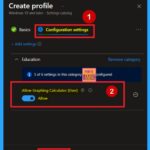
This policy setting means that whether graphing functionality is available in the Windows Calculator app. If disabled, users won’t have access to graphing functionality. If enabled or not configured, users will be able to use the graphing features in the app.
Allow or Block Graphing Calculator using Intune Policy – CSP Details
Above we discussed Enable or Disable Allow Graphing Calculator Using Intune Policies. Before deploying this policy, it is essential to understand the CSP (ConfigurationService Provider) details. This setting is only a placeholder and should not be used in a production environment.
| Property name | Property value |
|---|---|
| Format | int |
| Access Type | Add, Delete, Get, Replace |
| Default Value | 1 |

- How to Create Intune Settings Catalog Policy
- Easy way to Enable Education Themes via Setting Catalog in Intune
- Enable Disable Search to Use Location Policy using Intune
Create Profile
The first step is to sign into the Microsoft Intune admin center. There, navigate to Devices > Configuration, and click on the New policy button. When you click on the New policy button, a Create profile window will appear. Select the platform as Windows 10 and later and the profile type as Settings catalog.
- Then, click on the Create button.
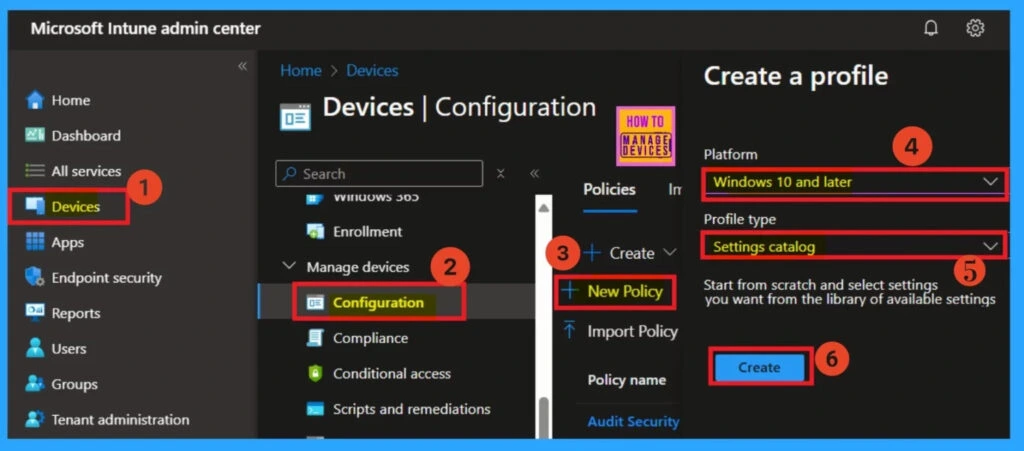
Basics
After creating a policy, the first step is Basics. In the Basics step, you need to enter the basic details about the policy, such as the name, description, platform details, etc. The platform is set to Windows by default. You have to enter a name for the policy and provide a description for the policy, as this will help you understand the policy later.
- I enterd the Name as Allow Graphing Calculator (User).
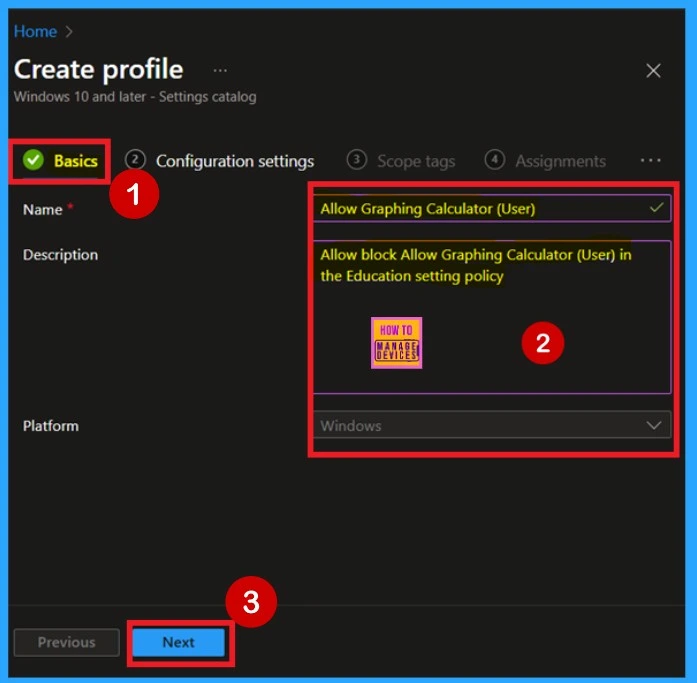
Configuration – Settings Picker
The next important step is Configuration settings. Here, you can add the settings policy to a group. First, click on the Add settings option, which is highlighted in blue. When you click on it, a window called Settings picker will appear. In the Settings picker, you need to select the Education category. When you click on the Education category, you will see a list of setting policies under Education.
- Here, you have to select the Allow Graphic Calculator policy.
- After selecting it, close the Settings picker window.
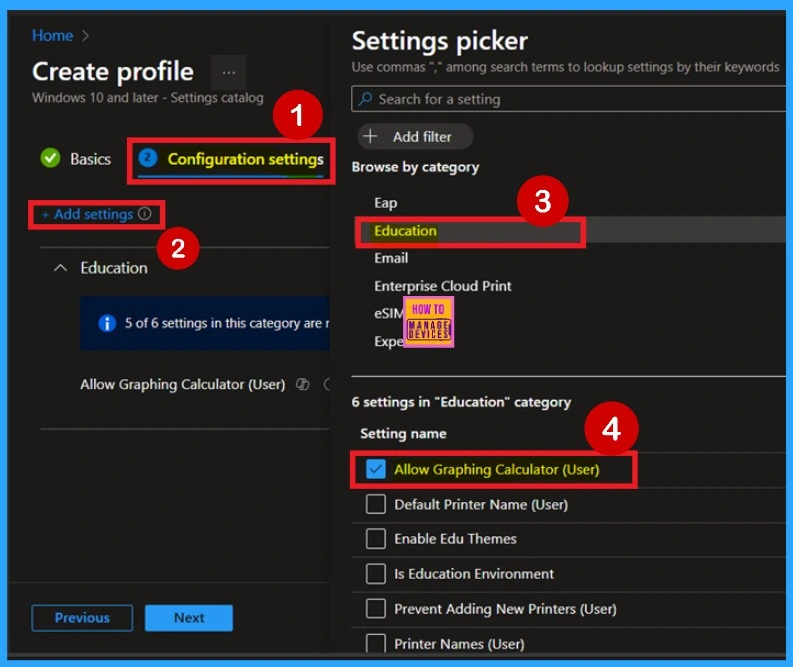
Graphing Calculator – Allowed
When you click on the Allow graphing calculator policy, you can then close the Settings picker window. After closing the settings window, you will be back on the Configuration settings page. Here, you can see that this policy is Allowed for users by default. If you want to continue with this setting, click on Next.
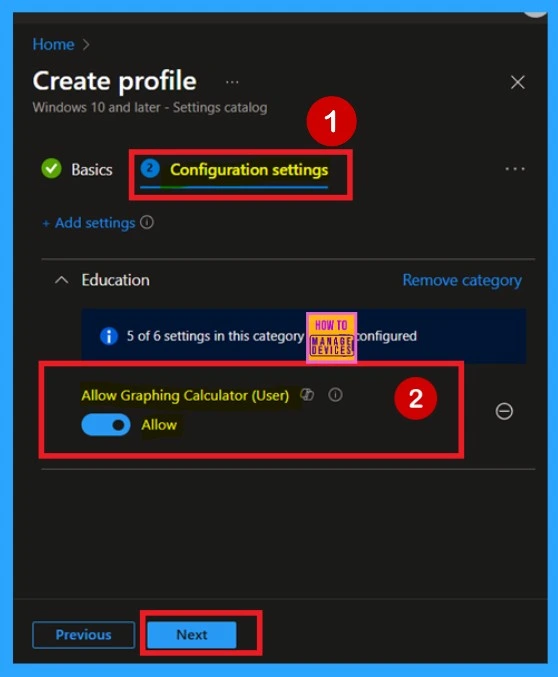
Graphing Calculator – Blocked
Here, I want to disable this policy, means that I want to block it. To do this, I toggle the pane from the right to the left. Now, the policy is blocked. When the policy is blocked, you will notice that the toggle switch turns black and the blue color disappears and it shows “Blocked.” Then, click Next to continue the procedure.
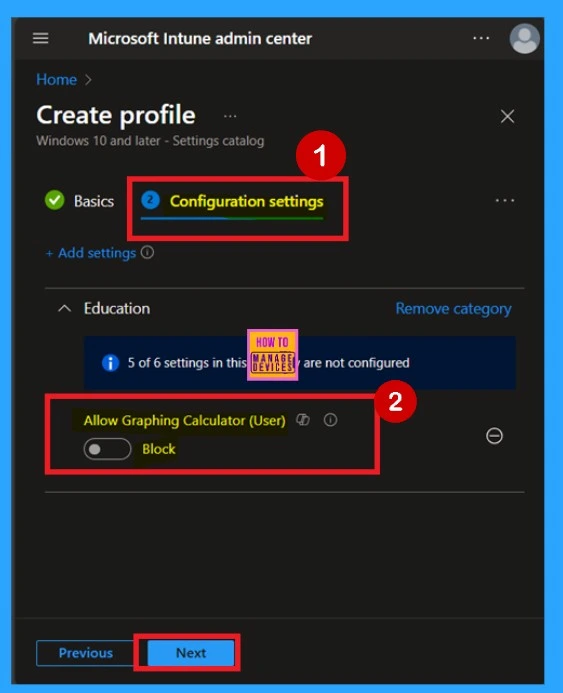
Scope Tags
The next step is Scope tags, which help you organize and manage access to the policy, such as for the department or location. This section is optional, so if you don’t want to apply the Scope tags, just click Next to continue.
- Here I choose to Skip the Section.
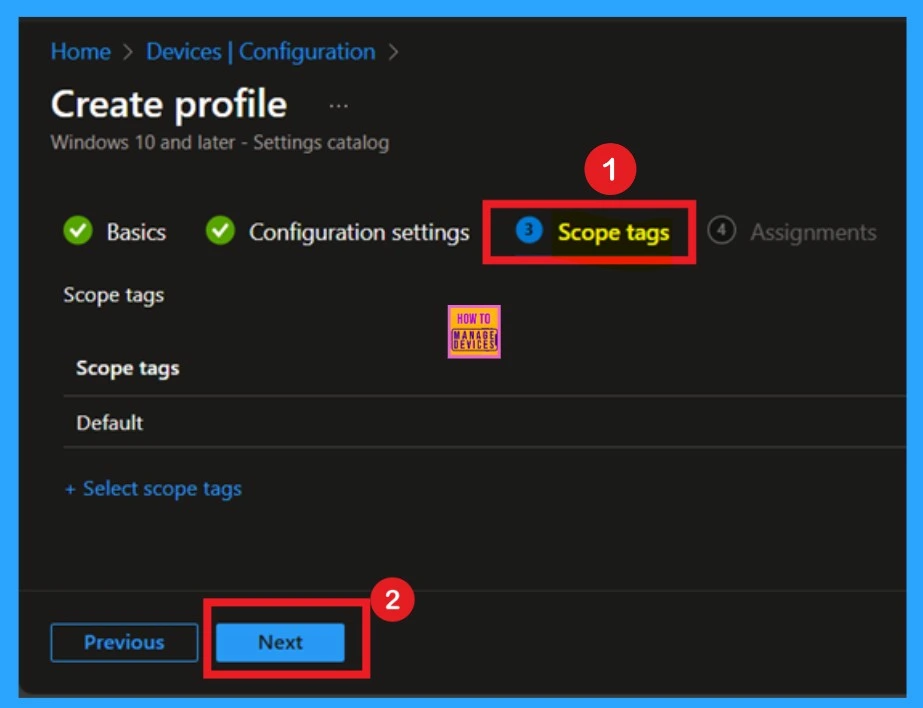
Assignments
Assignment is another important step you need to complete, just like Configuration settings. In this step, you have to decide which group you want to deploy the policy to. First, click on Add groups under the Include groups section, and select the group to which you want to apply the policy. Then, click Next to continue.
- Always remember, you must click on Add groups under the Include groups option.
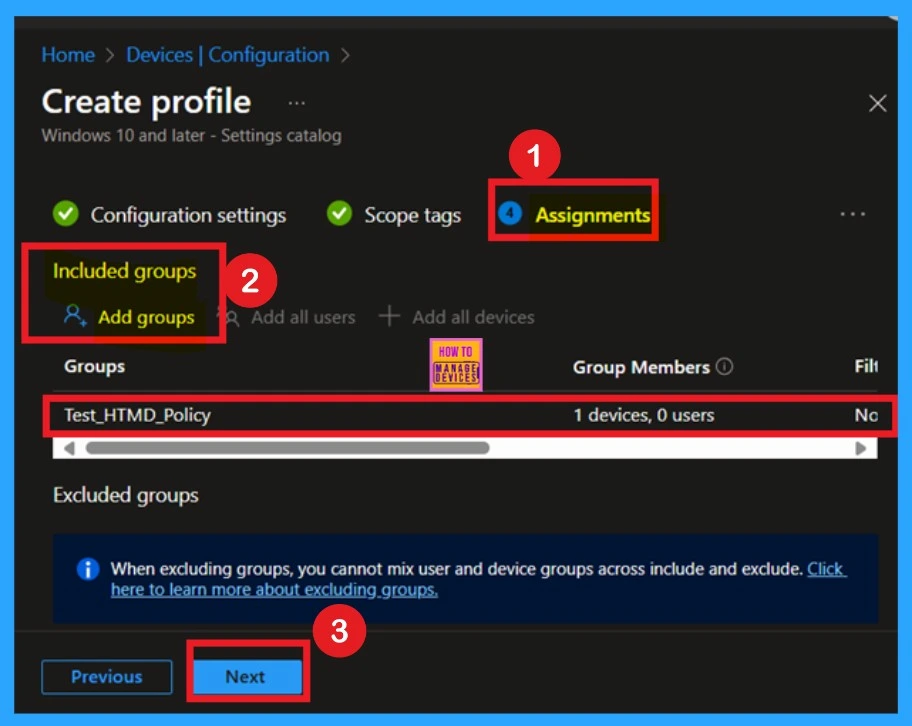
Review + Create
Review + Create is the final step in the policy creation process. You will reach this section after completing the Assignment step. This section acts like a summary page, showing all the steps you have previously completed. If you notice any mistakes, this is your final chance to edit them. If everything looks correct, click on the Create button.
- Once you click Create, you will receive a notification confirming that the policy has been created successfully.
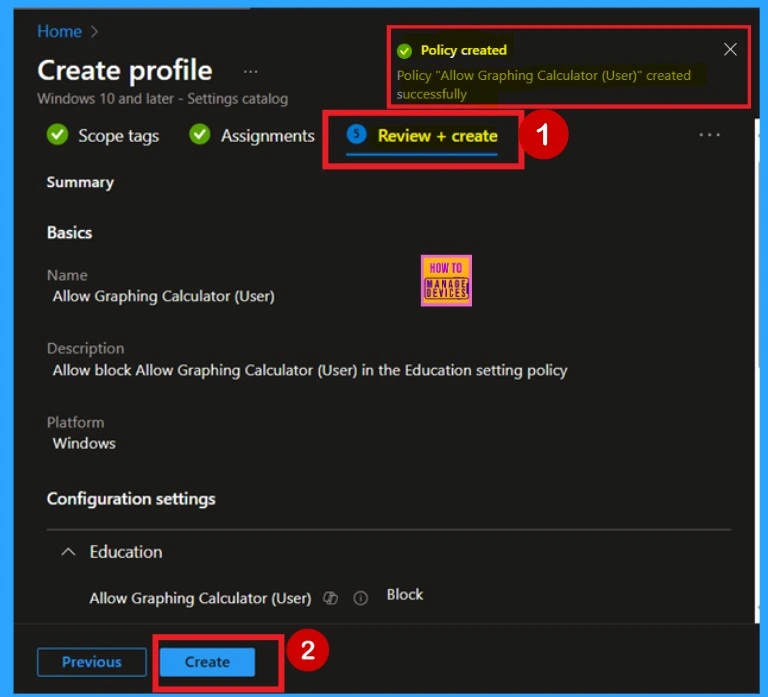
Monitoring Status
After creating a policy, the main concern is whether the policy has been deployed successfully or not. As you know, the policy creation takes an 8-hour waiting period. However, if you sync the policy, it will be applied quickly. I sync the policy through the company portal and then checking the monitoring status. Follow these steps to check monitoring status:
- Open the Microsoft Intune admin portal.
- Then Navigate to the Devicces> Configurations.
- In the configurations, select the policy you previously created or the policy for which you want to check the success status.
- You will then be able to view the monitoring status and confirm whether it succeeded or not.
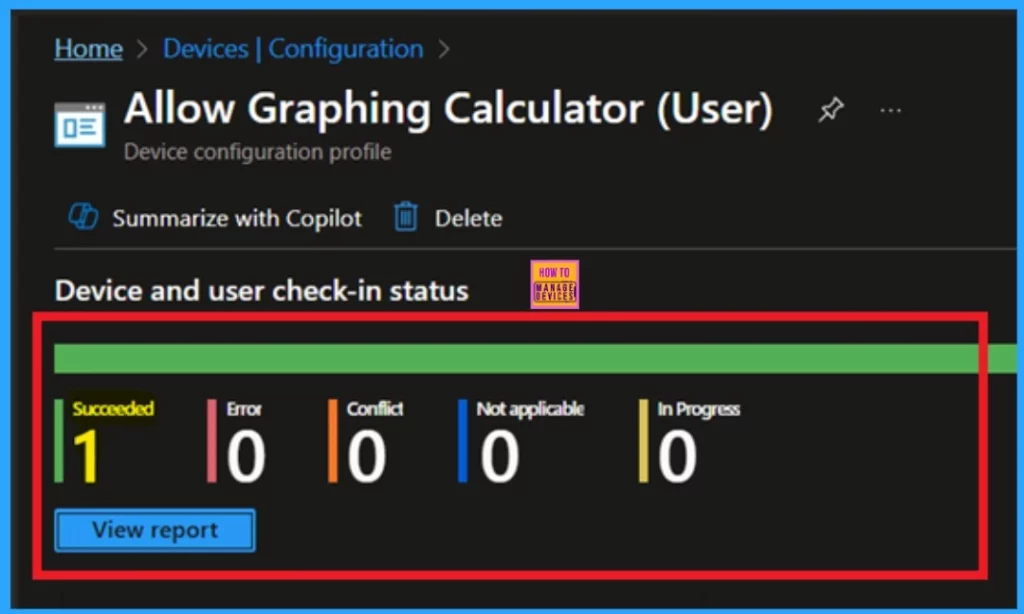
Client-Side Verification
The next confirmation of the Policy succeeds or not is by checking the client side verification. Here first go to the Event Viewer and check the Event ID that is usually in 813 or 814. Navigate to Applications and Services Logs > Microsoft > Windows > Device Management > Enterprise Diagnostic Provider > Admin.
- I get the policy details in the 813 Event ID Number.
| Policy Details |
|---|
| MDM PolicyManager: Set policy int, Policy: (AllowGraphingCalculator), Area: (Education), EnrollmentiD requesting merge: (B1E9301C-8666-412A-BA2F-3BF8A55BFA62), Current User: (S-1- 12-1-3449773194-1083384580-749570698-1797466236), Int: (0x0), Enrollment Type: (0x6), Scope: (0x1). |
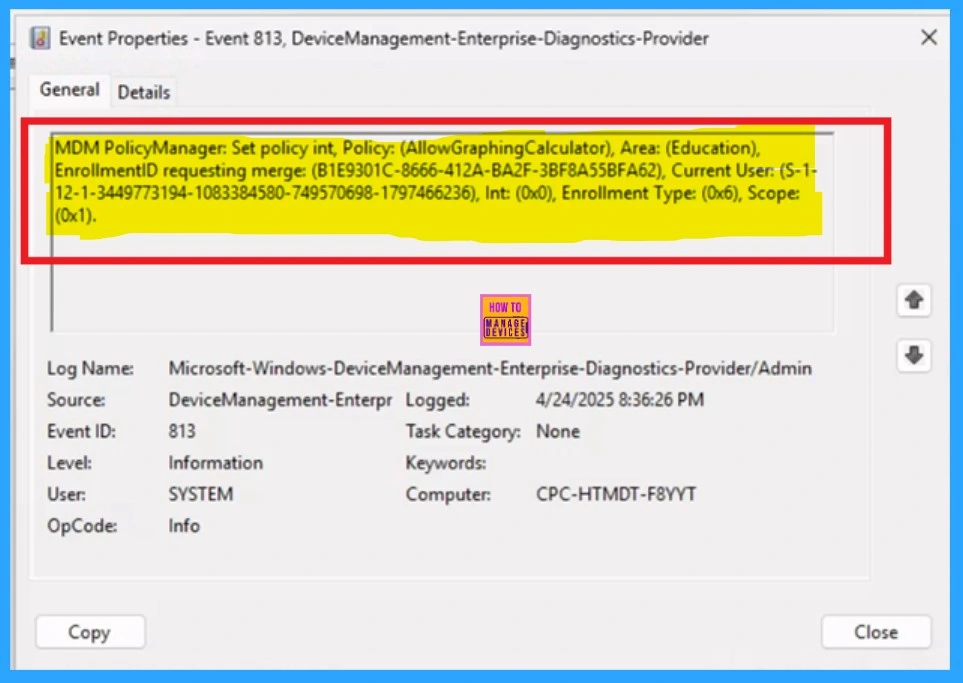
Remove Graphing Calculator Policy
Intune allows you to easily remove the Allow Graphing Calculator policy from your tenant. To do this, open the policy from the Configuration tab and click on the Edit button on the Assignment tab. Click on the Remove button on this section to remove the policy.
For more detailed information, you can check our previous post – Learn How to Delete or Remove App Assignment from Intune using by Step-by-Step Guide.

Delete Graphing Calculator Policy
If you want to delete the Allow Graphing Calculator policy, first go to the Device >Configurations section. In the Policy section, search for Allow Graphing. Once you find the policy in the list, click on the 3-dot menu next to it. From the options that appear, select Delete to remove the policy.
For More Information review the post: How to Delete Allow Clipboard History Policy in Intune Step by Step Guide
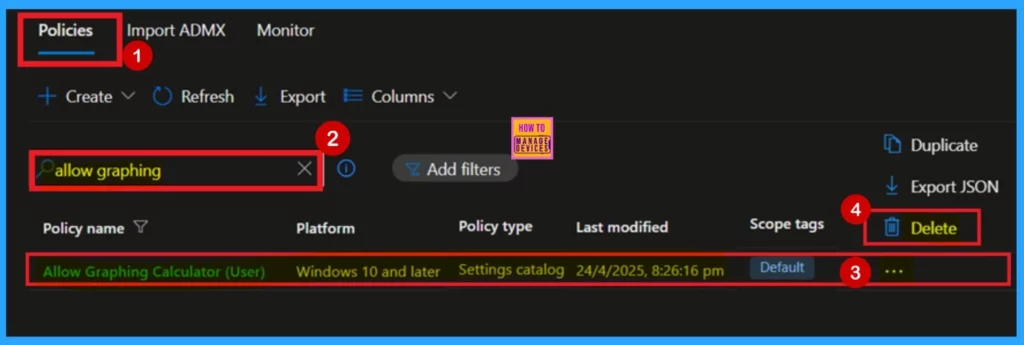
Need Further Assistance or Have Technical Questions?
Join the LinkedIn Page and Telegram group to get the latest step-by-step guides and news updates. Join our Meetup Page to participate in User group meetings. Also, Join the WhatsApp Community to get the latest news on Microsoft Technologies. We are there on Reddit as well.
Author
Anoop C Nair has been a Microsoft MVP for 10 consecutive years from 2015 onwards. He is a Workplace Solution Architect with more than 22+ years of experience in Workplace technologies. He is a Blogger, Speaker, and Local User Group Community leader. His primary focus is on Device Management technologies like SCCM and Intune. He writes about technologies like Intune, SCCM, Windows, Cloud PC, Windows, Entra, Microsoft Security, Career, etc.
